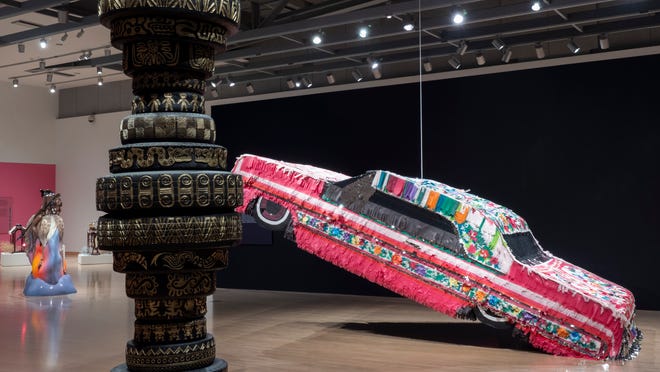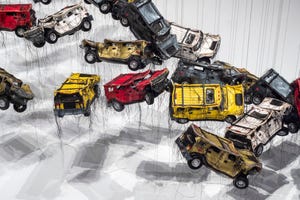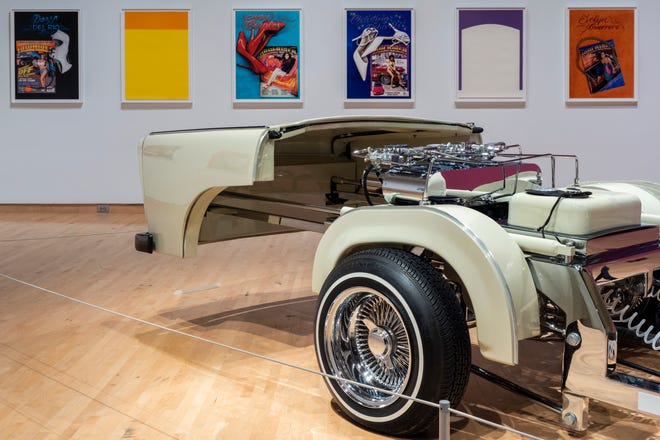[ad_1]

Cars as art?
Trends in metro Phoenix say yes.
Two exhibitions — “Laloland” at Mesa Arts Center and “Desert Rider” at Phoenix Art Museum — highlight lowrider culture, a distinctively American art form.
“Desert Rider” runs through Sept. 18 and features artwork by more than 12 Latin and Indigenous artists from Arizona and the Southwest. “Laloland,” which blends lowrider culture with Chicano artwork, is open through Aug. 7 and features of the work of Phoenix muralist and artist Lalo Cota.
Lowrider culture originated in Southern California, Texas and the Southwest after World War II. It was an expression of art, family and religion within Chicano and Latin American cultures, according to the National Museum of African American History and Culture. Lowrider cars — then and now — are converted and refurbished artistic statements.
“The automobile affects every part of who we are,” said Gilbert Vicario, Phoenix Art Museum’s chief curator. “And lowrider culture has changed dramatically in the last 10 years, just because there’s so much more to embrace. It’s a testament to the fact that it’s an incredible art form.”
Save money:These metro Phoenix museums have free admission this summer
What inspired ‘Desert Rider’ at the Phoenix Art Museum
“Desert Rider” displays mixed media projects including the large-scale “Gypsy Rose Piñata,” a life-size piñata of the famous Gypsy Rose car designed by Jesse Valadez in 1963. Other works include motorcycle saddles, handcrafted skateboards and photos of automobiles.

Artists include Carlotta Boettcher, Margarita Cabrera, Liz Cohen, Justin Favela, Sam Fresquez, Luis Jiménez, Douglas Miles, Betsabee Romero, Cara Romero, Frank Romero, Laurie Steelink and Jose Villalobos.
Phoenix Art Museum has a history with car exhibits, Vicario said. In 2019, “Legends of Speed” presented more than 20 race cars. In 2007, “Curves of Steel” highlighted 20th century streamlined European and American automobiles.
In 2019, Vicario wanted to curate another automobile-focused exhibition. At first, it centered on traditional lowrider culture and then expanded to blend Latin and Native American artwork portraying car culture in the Southwest.
Vicario began brainstorming and, slowly, curators from across the Southwest and even South America assembled “Desert Rider.” With its title inspired by the 1969 film “Easy Rider,” the exhibit showcases how landscape and freedom work together through automobile culture.
“When you walk into the show, everything is a surprise,” Vicario said. “Everything is visually so interesting. The stories that emerge from ‘Desert Rider’ are ones you really wouldn’t expect.
“I realized there was an opportunity to tell a very different story about lowriding in the Southwest. It turned into something that opens the bigger conversation beyond just lowriding and the car design and thinking about how women have been excluded from lowriding.”
Look down:The floor is art in the Phoenix airport’s new Southwest Airlines concourse
Lowrider piñata is ‘my fun retaliation’
From the early 1980s, Las Vegas artist Justin Favela remembers seeing lowriders on TV, predominantly representing gangster culture. That inspired him to focus on the positive aspects of lowrider culture, specifically within the “Gypsy Rose Piñata.”
“Lowrider represents so much of not only the unity between families, but also the ties to religion and a lot of homage to Christianity,” Favela said. “It’s also this beautiful idea of a car resurrecting the car. It’s a symbol of American progress and for Latinos to take that and really make it their own.”
His piñatas started as a response to stereotypes within Latin artwork.
“If you’re not a white man in the art world, you’re not really allowed to make art about whatever you want to be about,” Favela said.
“The art world kind of pushes you to make art about your trauma, your biography or, you know, your identity. And so this was my fun retaliation. I thought, ‘I’m going to find the cheesiest symbol I can find and make it my medium.’”
Happy Pride! Celebrate Pride Month in metro Phoenix with drag shows, bar crawl
‘I’m going to learn to do this’

At 77, mixed media artist Carlotta Boettcher is the oldest artist in the exhibition. Born in Cuba and based in Guatemala, Boettcher has spent her life immersed in car culture. One car in particular changed her perspective on art.
“I saw a car out on the street that was badly damaged,” Boettcher said. “It was really, really wrecked and it caught my eye. But it was still running. So it drove past me. And about a month later I saw that car and it was perfect. I thought to myself, ‘I’m going to learn to do this.’”
So began Boettcher’s love of creating art cars — wrapping car exteriors in colorful paint finishes — photographing car
s across the world and creating art pieces celebrating the automobile. Boettcher earned a master’s degree in film and visual anthropology, and both themes are expressed through her works in “Desert Rider.”
Boettcher’s works in the show include two car hoods. One is titled “Desert Shield” and focuses on her disillusionment with the Vietnam War. Boettcher also features 24 digital prints on cotton rag paper, all photos of automobiles she captured in fields across northern New Mexico in 1996.
“As I drove through the countryside of those areas, I would spot these cars in the most unlikely places off the road, in the field, in the gutter, in the ravine or just kind of tossed like a broken toy, and they were in the most unlikely position. And so I photographed them.”
Other “Desert Rider” highlights include a sculpture with an automotive finish that details a Native American on horseback by Luis Jiménez and Douglas Miles’ wall of Apache skateboards.
Lalo Cota and more:Here’s where to find the best new murals in Phoenix
What to look for at ‘Laloland’

For Lalo Cota, lowriders have always inspired his art and are often seen in his paintings and murals across the Valley.
“I wasn’t consciously highlighting lowrider culture. My work is a reflection of my love for cars and my lowriding experience,” Cota said in an email.
Because his works are predominantly murals, “Laloland” gives Cota a chance to show large-scale art works not usually seen by the public. Each work incorporates Cota’s unique East Coast graffiti hip hop influences with his Chicano-style, lowrider art.
“Although I’m mostly recognized for my paintings of skulls, I don’t paint death,” Cota said. “I hope my audience walks away entertained and inspired to live, love, laugh and create by my work.”
Phoenix Art Museum: ‘Desert Rider’
When: Through Sept. 18. Museum hours are 10 a.m.-5 p.m. Thursdays-Sundays, 10 a.m.-9 p.m. Wednesdays. Closed Mondays and Tuesdays.
Where: Phoenix Art Museum, 1625 N. Central Ave.
Admission: $5-$23 online in advance; $2 more in person.
Details: 602-257-1880, https://phxart.org.
Mesa Arts Center: ‘Laloland’
When: Through Aug. 7. Museum hours are 10 a.m.-5 p.m. Tuesdays-Saturdays and noon-5 p.m. Sundays.
Where: Mesa Arts Center, 1 E Main St.
Admission: Free.
Details: 480-644-6500, https://mesaartscenter.com.
Reach the reporter at [email protected]. Follow her on Instagram @sofia.krusmark.
[ad_2]
Source link


:strip_icc()/BHG_PTSN19720-33d9cd22f6ab49e6a21982e451321898.jpg)

More Stories
Fresh and Airy Interior Design Living Room Ideas for Summer
Where Art and Sound Converge: Exploring Fine Art Photography and Music Artist Portraiture
Cooking Chinese Cuisine with Ease Using Jackery Solar Generator 5000 Plus